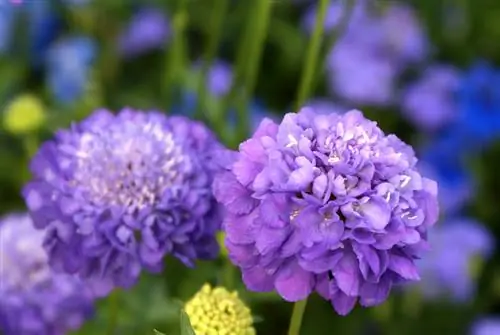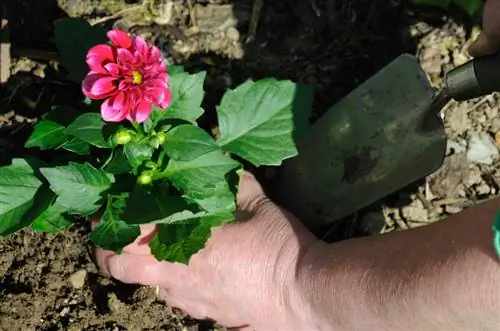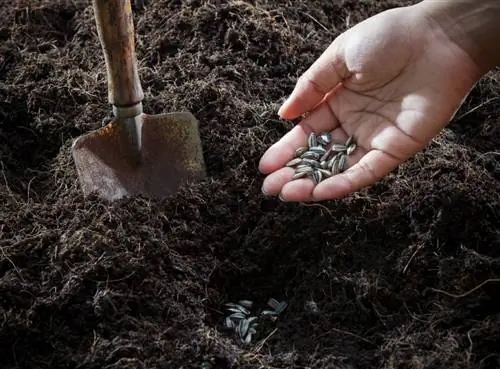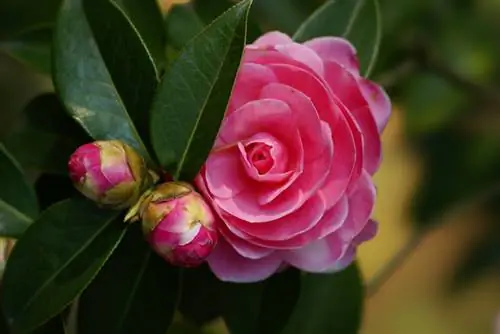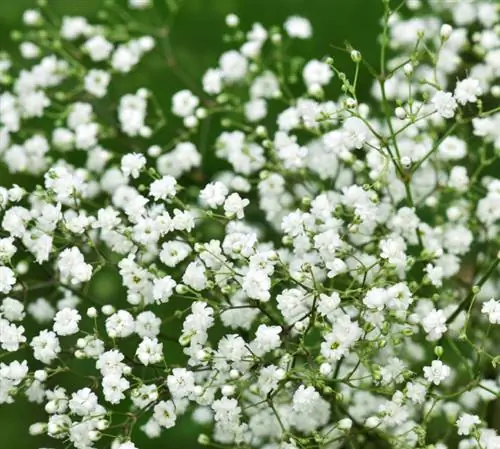- Author admin [email protected].
- Public 2023-12-25 17:45.
- Last modified 2025-01-23 11:22.
Its delicate flowers dance with delicate lightness over a bushy tuft of leaves. The scabiosis enchants as an elf-like perennial in cottage gardens and summer borders. The following answers to frequently asked questions reveal how you can coax a never-ending period of bloom from the graceful floral beauty.
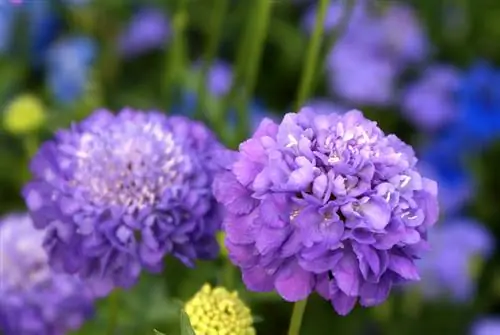
How do I care for scabioses for optimal flowering?
Scabioses require a location in full sun, slightly calcareous, well-drained and humus-rich soil, regular irrigation without waterlogging and moderate fertilization. In order to achieve a long flowering period, withered flowers should be cleaned out regularly.
Planting scabiosis correctly
May is the time to plant scabiosis that you have grown yourself or purchased ready-made. Welcome the perennial to the garden with a location in full sun that is characterized by loose, humus-rich and fresh soil. While the still potted root ball is soaked with water, create the planting pits at a distance of 35-40 cm. Mix compost, horn shavings and some garden lime or rock dust into the excavation. Plant a potted root ball in the middle of the planting hole and fill it with the substrate up to the bottom pair of leaves. After the soil has been pressed and watered, finally spread a layer of mulch with leaves or bark mulch.
Care tips
With its natural charm, the scabiosis transforms the garden into a summery sea of flowers if it is given the following care:
- Water regularly but moderately in the bed and pot
- Any waterlogging is fatal for the perennial
- Clean out wilted flowers every 2-3 days
- Administer booster fertilization with compost and horn shavings in April/May
- Add a liquid fertilizer to the watering water for scabioses in the pot
In autumn, cut the lanceolate, grass-like foliage to just above the ground. Bedding plants receive a protective layer of leaves, straw or brushwood, while the perennial in the pot moves to a frost-free winter quarters.read more
Which location is suitable?
With their colorful flowers, scabioses pay homage to the sun to grab every single ray from it. Therefore, give the summer perennial a location in full sun, warm and ideally protected from the wind. If the soil is still fresh, moist, nutrient-rich and well-drained, the care required for the scabious is reduced to a minimum.
What soil does the plant need?
The summer-flowering perennial feels comfortable in humus-rich, well-drained soil that tends to contain lime. A sandy-loamy, fresh soil texture ideally meets the requirements of scabiosis. In the pot and balcony box, the scabious flower shows its most beautiful side when it can stretch out its roots in standard potting soil (€5.00 on Amazon) that is enriched with sand, perlite or lava granules.
When is flowering time?
The length of the flowering period is up to the gardener. If you give scabioses a free hand, from June onwards a delicate sea of flowers will spread across the bed in beautiful shades of blue, pink or white. The head flower is surrounded by up to 3 rows of petals, which usually grow in decorative wavy shapes. Without your intervention, this unique flower spectacle will remain. By cleaning up the withered flowers immediately, the flowering period continues seamlessly into October.
Cutting scabios correctly
With the help of secateurs, you can encourage the perennial to bloom for a long time, which lasts for what feels like an eternity. If you consistently cut off the withered flower heads every few days, fresh buds will develop within a short time. A scabiosis cared for in this way shows no signs of fatigue from June until well into autumn. Ideally, you should only cut off the fallen leaves in late winter in order to additionally protect the root ball underneath.
Watering scabiosis
Water a scabiosis regularly during dry summers, because it thrives in fresh, moist soil. Under no circumstances should the perennial suffer from waterlogging, because the root ball cannot survive this dilemma. If the flower thrives in a planter, watering is usually required more frequently than in a bed. On hot summer days, check the moisture content of the substrate every day so that if the surface is dry, water immediately.
Fertilize scabiose properly
The perennial is modest when it comes to its nutrient supply. You have already covered this aspect of care with initial fertilization in spring. A well-measured portion of compost with horn shavings gives scabioses the plant energy they need for a lush abundance of flowers. After planting, the nutrient reserves in the pot and balcony box are used up within 4-6 weeks. Therefore, fertilize the perennial every 4 weeks until August with a liquid preparation for flowering plants.
Wintering
Apart from a few annual varieties, garden scabioses thrive as perennials. Although the above-ground parts of the plant move in over the course of the winter, the root ball can withstand freezing temperatures down to -34 degrees Celsius. For reasons of caution, we still recommend light winter protection for the floral grace by covering the root disc with leaves and brushwood after pruning. Cultivated in flower boxes and buckets, move the perennial to a frost-free area before winter. To prevent the root ball from drying out, water occasionally until spring. Fertilization is not carried out during wintering.
Propagate scabiosis
It only takes a few steps to propagate this pretty perennial. Experienced hobby gardeners swear by dividing the root ball, as this vegetative method preserves all the attributes of the mother plant. In early spring, dig up the root ball and cut it into the desired number of segments with a spade or knife. As long as a section has at least 2-3 buds or shoots, a magnificent new scabiosis will develop from it. It is important to note that the root pieces are planted exactly as deep as before and that they are then watered abundantly and regularly.
Scabiose in a pot
It is primarily the small pigeon scabioses that thrive wonderfully in pots. As a substrate, we recommend potting soil with a low peat content, which is optimized with sand, perlite or lava granules. A few pieces of pottery above the water drain act as drainage to prevent dangerous waterlogging. To care for the perennial in the pot, these measures are important:
- Water regularly when the potting soil dries out
- In the pre-fertilized substrate, fertilize for the first time after 4-6 weeks at the earliest
- Clean out wilted flowers every few days
- Pruning the grassy foliage close to the ground in autumn
- Repot in fresh soil in early spring
Throughout the winter, the perennial stays in a frost-free room to be watered a little every now and then. From May onwards, the scabiosis will take its usual place on the sunny balcony again.
Is scabiosis poisonous?
The common vernacular calls scabiosis, among other things, scabies herb. This title results from the fact that some species, such as pigeon scabioses, were used in medicine to relieve an unpleasant skin rash - scabies. Thanks to the valuable ingredients such as essential oils, minerals and vitamins, the leaves have a strengthening effect on the metabolism as a tea or in salad. The perennial can therefore rightly be classified as medicinal and herbal plants, without any toxic danger to humans and animals.
Beautiful varieties
- Clive Greaves: A delicate floral beauty with light purple flowers that spread out in a radiating pattern; Growth height 90 cm
- Perfecta Alba: The perennial does what the variety name promises with pure white flowers; Growth height 70 cm
- Stäfa: A premium variety with two-tone flower heads in light and dark violet shades; Growth height 80 cm
- Pigeon scabiose: Pretty mini variety with double flowers in light blue and white; ideal for the balcony with a height of 25 cm
- Pink Mist: Distinctive pigeon scabiosis, whose pink flowers bloom lushly from June to October; Growth height 25 cm

